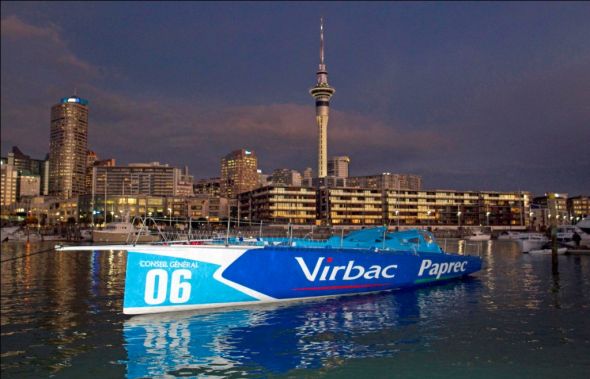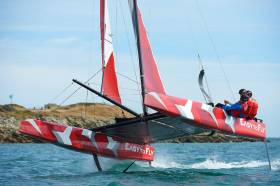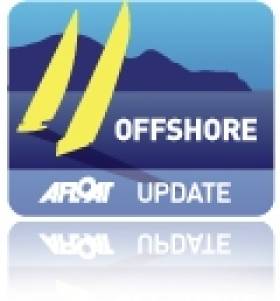Displaying items by tag: JeanPierre Dick
New Foiling Catamaran Is ‘Easy To Fly’
#Foiling - Orders are flying in for a new design foiling catamaran, according to its French makers.
Easy to Fly is the brainchild of solo sailor Jean-Pierre Dick, who placed fourth in the most recent Vendée Globe, and Guillaume Verdier, designer behind the new foiling One Design monohull chosen for future editions of the Volvo Ocean Race.
The 26ft multihull is designed to fly safely from a wind speed of 8 knots with three people on board — and is likely to be a future fixture on a French sailing scene that’s fully embraced foilingfoiling as a discipline.
Launched in September 2016, sales for Easy to Fly are up to six across Europe — including one to England, to the team behind the Open7.50 Cool Runnings, who will take delivery of their boat next week.
Foiling is in right now. And with Olympic hero Annalise Murphy leading the Irish charge in the relatively new class, there’s never been a better time to get on board and get flying on foils.
Visit www.EasyToFly.fr for more.
Dick Goes in Search of Double Win
Three years after his victory in the first Barcelona World Race with Damian Foxall (in 92 days, 09 hours, 49 minutes and 49 seconds at an average speed of 11.13 knots), Jean-Pierre Dick is doing the double-handed three cape route again. For his second time competing in this race leaving the Catalan city, he will be setting off in the good company of a very well-known figure in offshore racing: Loïck Peyron. The two are already a right pair, all set to dance a very fine two step across the world's oceans. Unquestionably, these talented gentlemen skippers make up a very stylish and dynamic duo, as can be seen from their victory in the Transat Jacques Vabre in 2005, or from their collaboration in the design and the construction to the two sisterships for the previous Vendée Globe. Among the combinations promising success, these partners, together in the Virbac-Paprec 3 cockpit, designed to cut through the waves, will definitely count among the tandems with expertise in sailing in extreme conditions. In all, there will be plenty to spice up the race between top sailors in this circumnavigation, which promises to be highly intense, with a victory in view.
Virbac-Paprec 3 is Launched for Vendee Globe
Jean-Pierre Dick's brand new 60 foot monohull, Virbac-Paprec 3, has just been launched in Auckland, New Zealand. As for the first two boats, once again the design team has innovated and the VPLP Verdier plans mark a radical break with the two previous monohulls skippered by him. Afloat.ie readers will recall Dick was partner with Ireland's Damian Foxall when they won the Barcelona World race two years ago.
The French skipper now has a new vessel on which to go in search of the Holy Grail: the Vendée Globe 2012. Between now and then, the schedule is busy with a half round-the-world, the Route du Rhum and the Barcelona World Race.
What is the philosophy of your new boat?
Jean-Pierre Dick: "The philosophy is monastic! Virbac-Paprec 3 will be a very light boat and therefore spartan. Paprec-Virbac 2 was a palace in comparison! This is the ultimate boat for extreme races in which there is complete physical and moral involvement. I now have sufficient experience in offshore racing to do without the unnecessary and only to think of the objective! The only items of comfort will be the seats on board for steering and sailing preparation, a berth designed by a bedding specialist and two helm stations which are real cocoons."
What are the main characteristics of Virbac-Paprec 3?
" The bi-roof. We have created two cocoons under a Plexiglas dome to provide a perfect view; much as you would have in a helicopter. They will enable me to watch and steer in all weather and stay dry. Before, there were two distinct stations, so this means a reduction in weight. This work is a continuation of that carried out on Paprec-Virbac 2 with the sliding roof. The difference is that this time we agree to manoeuvre wet.
Lightness Virbac-Paprec 3 is 10 to 15% lighter than Paprec-Virbac 2. At each step in the construction, we found the means to simplify; to find a lighter and more intelligent way of building her. For example, the chart table is only a computer screen on a rotating stand with a seat that can be moved from one side to the other. The boat is completely empty inside! The advantage is the capacity to make quicker progress with less sails or to keep it longer. The skipper does less manoeuvring and saves more of his energy.
Hydrodynamics We have designed 70 hulls with architects. Four were retained and tested in the test tank. To finish, they sailed a virtual round-the-world routed by a meteorologist to make the final choice. The lines are very taut and they have sharp bilges.
Aerodynamics
We have a standard mast with two spreaders, but with only one backstay cable* instead of 3. This is an innovation to reduce weight and wind factor. Safety We have focussed on safety by learning from unfortunate experiences. We have designed a safety hatch in the centre of the hull, so as not to have to leave the yacht from the rear. This hatch is pre-cut in the carbon and I will be able to saw it open if I find myself upturned. We have strengthened the watertight bulkheads to prevent the boat from filling up with water completely, at all costs.
What is the Virbac-Paprec 3 programme?
"One of the advantages of building in New Zealand is the return journey to France by sea. This helps us to get to know and perfect the new IMOCA 60 in real sailing conditions and on a world scale. This requires a lot of involvement, since it lasts 2 months but is extremely rewarding for the team and I. When I arrive in Lorient in mid-July, the boat will already have sailed more than 12,000 miles (22,224 km), or the equivalent of three transatlantics. So this is a perfect test bench for the run up to a busy end of the year with the Route du Rhum and the Barcelona World Race, in which I will be defending my title!"

































































